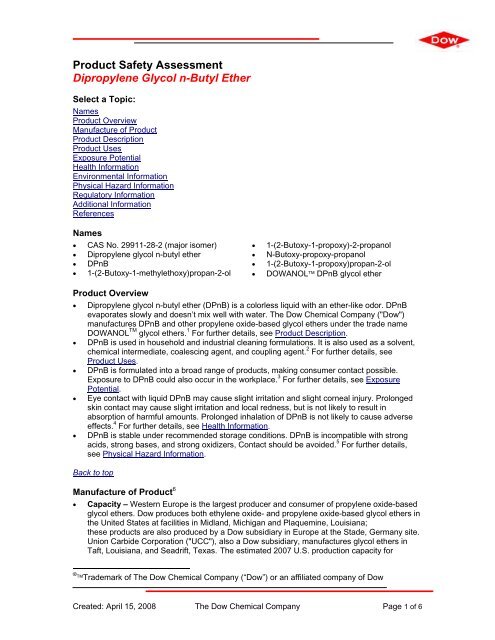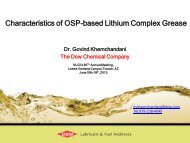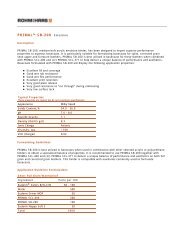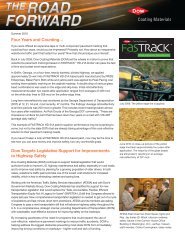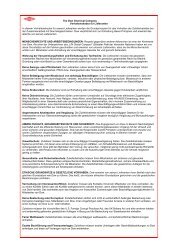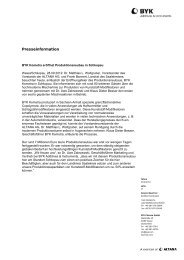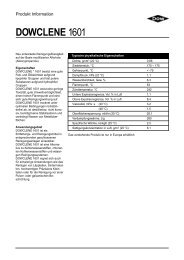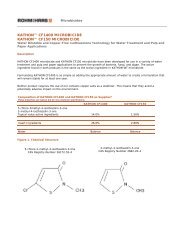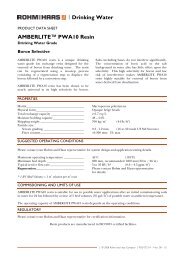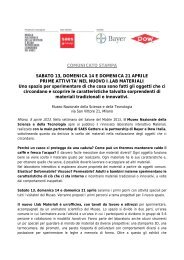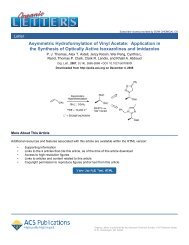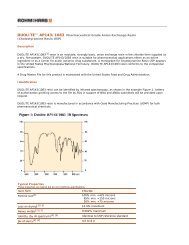Product Safety Assessment Dipropylene Glycol n-Butyl Ether
Product Safety Assessment Dipropylene Glycol n-Butyl Ether
Product Safety Assessment Dipropylene Glycol n-Butyl Ether
You also want an ePaper? Increase the reach of your titles
YUMPU automatically turns print PDFs into web optimized ePapers that Google loves.
<strong>Product</strong> <strong>Safety</strong> <strong>Assessment</strong><br />
<strong>Dipropylene</strong> <strong>Glycol</strong> n-<strong>Butyl</strong> <strong>Ether</strong><br />
Select a Topic:<br />
Names<br />
<strong>Product</strong> Overview<br />
Manufacture of <strong>Product</strong><br />
<strong>Product</strong> Description<br />
<strong>Product</strong> Uses<br />
Exposure Potential<br />
Health Information<br />
Environmental Information<br />
Physical Hazard Information<br />
Regulatory Information<br />
Additional Information<br />
References<br />
Names<br />
• CAS No. 29911-28-2 (major isomer) • 1-(2-Butoxy-1-propoxy)-2-propanol<br />
• <strong>Dipropylene</strong> glycol n-butyl ether • N-Butoxy-propoxy-propanol<br />
• DPnB • 1-(2-Butoxy-1-propoxy)propan-2-ol<br />
• 1-(2-Butoxy-1-methylethoxy)propan-2-ol • DOWANOL DPnB glycol ether<br />
<strong>Product</strong> Overview<br />
• <strong>Dipropylene</strong> glycol n-butyl ether (DPnB) is a colorless liquid with an ether-like odor. DPnB<br />
evaporates slowly and doesn’t mix well with water. The Dow Chemical Company ("Dow")<br />
manufactures DPnB and other propylene oxide-based glycol ethers under the trade name<br />
DOWANOL TM glycol ethers. 1 For further details, see <strong>Product</strong> Description.<br />
• DPnB is used in household and industrial cleaning formulations. It is also used as a solvent,<br />
chemical intermediate, coalescing agent, and coupling agent. 2 For further details, see<br />
<strong>Product</strong> Uses.<br />
• DPnB is formulated into a broad range of products, making consumer contact possible.<br />
Exposure to DPnB could also occur in the workplace. 3 For further details, see Exposure<br />
Potential.<br />
• Eye contact with liquid DPnB may cause slight irritation and slight corneal injury. Prolonged<br />
skin contact may cause slight irritation and local redness, but is not likely to result in<br />
absorption of harmful amounts. Prolonged inhalation of DPnB is not likely to cause adverse<br />
effects. 4 For further details, see Health Information.<br />
• DPnB is stable under recommended storage conditions. DPnB is incompatible with strong<br />
acids, strong bases, and strong oxidizers, Contact should be avoided. 5 For further details,<br />
see Physical Hazard Information.<br />
Back to top<br />
Manufacture of <strong>Product</strong> 6<br />
• Capacity – Western Europe is the largest producer and consumer of propylene oxide-based<br />
glycol ethers. Dow produces both ethylene oxide- and propylene oxide-based glycol ethers in<br />
the United States at facilities in Midland, Michigan and Plaquemine, Louisiana;<br />
these products are also produced by a Dow subsidiary in Europe at the Stade, Germany site.<br />
Union Carbide Corporation ("UCC"), also a Dow subsidiary, manufactures glycol ethers in<br />
Taft, Louisiana, and Seadrift, Texas. The estimated 2007 U.S. production capacity for<br />
® Trademark of The Dow Chemical Company (“Dow”) or an affiliated company of Dow<br />
Created: April 15, 2008 The Dow Chemical Company Page 1 of 6
<strong>Product</strong> <strong>Safety</strong> <strong>Assessment</strong>: <strong>Dipropylene</strong> <strong>Glycol</strong> n-<strong>Butyl</strong> <strong>Ether</strong><br />
propylene oxide-based glycol ethers including DPnB is 191,000 metric tons (420 million<br />
pounds).<br />
• Process – Propylene glycol ethers are manufactured in closed, continuous systems. DPnB is<br />
manufactured by reacting propylene oxide with n-butyl alcohol as shown below.<br />
Back to top<br />
CH3<br />
CH3 CH3<br />
C4H9 OH + 2 H2C<br />
O<br />
CH<br />
C4H9 OCH2CH O CH2CH OH<br />
n-<strong>Butyl</strong> alcohol Propylene<br />
oxide<br />
<strong>Dipropylene</strong> glycol n-butyl ether<br />
<strong>Product</strong> Description 7,8,9<br />
<strong>Dipropylene</strong> glycol n-butyl ether (DPnB) is a colorless liquid with an ether-like odor. It evaporates<br />
slowly and does not mix well with water. DPnB is a propylene oxide-based, or P-series, glycol<br />
ether. DPnB is a mixture of four isomers. (Isomers are molecules with the same chemical formula<br />
but different structures.) Dow manufactures DPnB and other P-series glycol ethers under the<br />
trade name DOWANOL glycol ethers.<br />
Back to top<br />
<strong>Product</strong> Uses 10,11,12,13,14<br />
DPnB is widely used for industrial and<br />
residential applications, such as:<br />
• Cleaning formulations – acts as a<br />
coupling agent and solvent in<br />
household and industrial cleaners<br />
such as all-purpose, kitchen, and<br />
bathroom cleaners; grease and paint<br />
removers; hard-surface cleaners; and<br />
laundry pre-wash stain removers<br />
• Surface coatings – architectural,<br />
automotive refinishes and topcoats,<br />
and industrial maintenance coatings<br />
for corrosion control<br />
• Coalescing agent – latex coatings<br />
Primary U.S. Uses for DPnB 14<br />
Created: April 15, 2008 The Dow Chemical Company Page 2 of 6<br />
Inks<br />
5%<br />
Cleaners<br />
85%<br />
Surface<br />
coatings<br />
10%<br />
• Chemical intermediate – for the production of epoxides, acid ester derivatives, solvents, and<br />
plasticizers<br />
• Coupling agent and solvent – water-reducible and solvent-based coatings<br />
• Inks<br />
• Cosmetics<br />
Back to top<br />
Exposure Potential<br />
DPnB is used in the production of industrial and consumer products. Based on the uses for DPnB,<br />
the public could be exposed through:<br />
• Workplace exposure 15,16 – Exposure can occur either in a DPnB manufacturing facility or in<br />
the various industrial or manufacturing facilities that use DPnB. Those working with DPnB in<br />
manufacturing operations could be exposed during maintenance, sampling, testing, or other<br />
procedures. Each manufacturing facility should have a thorough training program for<br />
® Trademark of The Dow Chemical Company (“Dow”) or an affiliated company of Dow
<strong>Product</strong> <strong>Safety</strong> <strong>Assessment</strong>: <strong>Dipropylene</strong> <strong>Glycol</strong> n-<strong>Butyl</strong> <strong>Ether</strong><br />
employees and appropriate work processes, ventilation, and safety equipment in place to<br />
limit unnecessary exposure. See Health Information.<br />
• Consumer exposure to products containing DPnB 17 – Dow does not sell DPnB for direct<br />
consumer use, however, consumers can be exposed through the use of home cleaning<br />
products, paint removers, or other products containing DPnB. The typical DPnB<br />
concentration in cleaners is 2 to 10%. See Health Information.<br />
• Environmental releases 18 – In the event of a spill, the focus is on containing the spill to<br />
prevent contamination of soil, ditches, sewers, waterways, or groundwater. For small spills,<br />
DPnB should be absorbed with sand or vermiculite. Collect the material in suitable and<br />
properly labeled containers. See Environmental Information, Health Information, and Physical<br />
Hazard Information.<br />
• Large release – Industrial spills or releases are infrequent and generally contained. If a large<br />
spill does occur, contain spilled material if possible. Pump into suitable and properly labeled<br />
containers using appropriate safety equipment.<br />
• In case of fire – Keep people away and deny unnecessary entry. Wear positive-pressure,<br />
self-contained breathing apparatus (SCBA) and protective fire-fighting clothing or fight the fire<br />
from a safe distance. Consider the use of unmanned hose holders or monitor nozzles. Do not<br />
use a direct water stream (may spread fire). Use water fog or fine spray, carbon-dioxide or<br />
dry-chemical extinguishers, or foam. Follow emergency procedures carefully. See<br />
Environmental Information, Health Information, and Physical Hazard Information.<br />
For more information, see the relevant <strong>Safety</strong> Data Sheet.<br />
Back to top<br />
Health Information 19<br />
Eye contact with liquid DPnB may cause slight irritation and corneal injury. Prolonged skin contact<br />
may cause slight irritation but is not likely to result in absorption of harmful amounts. Prolonged<br />
inhalation of DPnB is not likely to cause adverse effects. DPnB was not a skin sensitizer in<br />
animals or humans.<br />
DPnB has low toxicity if swallowed. Swallowing small amounts incidental to normal handling is<br />
unlikely to cause injury. However, swallowing larger amounts may cause injury. Significant<br />
effects are not expected following acute or prolonged inhalation of vapor or aerosol exposures.<br />
DPnB does not cause fetal toxicity, birth defects or reproductive effects. Genetic toxicity studies<br />
were also negative.<br />
For more information, see the relevant <strong>Safety</strong> Data Sheet.<br />
Back to top<br />
Environmental Information 20<br />
DPnB is not likely to accumulate in the food chain (bioconcentration potential is low) and is readily<br />
biodegradable. DPnB is practically nontoxic to aquatic organisms on an acute basis.<br />
For more information, see the relevant <strong>Safety</strong> Data Sheet.<br />
Back to top<br />
Physical Hazard Information 21<br />
DPnB is stable under recommended storage conditions. It should be stored in carbon steel,<br />
stainless steel, or phenolic-lined steel drums. Do not store in aluminum, copper, galvanized steel,<br />
or galvanized iron. DPnB can oxidize (decompose) at elevated temperatures. Generation of gas<br />
during decomposition can cause pressure build-up in closed systems. Decomposition products<br />
Created: April 15, 2008 The Dow Chemical Company Page 3 of 6
<strong>Product</strong> <strong>Safety</strong> <strong>Assessment</strong>: <strong>Dipropylene</strong> <strong>Glycol</strong> n-<strong>Butyl</strong> <strong>Ether</strong><br />
depend on temperature, air supply, and the presence of other materials, but can include<br />
aldehydes, ketones, and organic acids.<br />
DPnB is incompatible with strong acids, strong bases, and strong oxidizers. Avoid contact with<br />
these materials.<br />
During a fire, smoke may contain the original material in addition to varying compositions of toxic<br />
or irritating combustion products. Combustion products may include and are not limited to carbon<br />
monoxide and carbon dioxide. Violent steam generation or eruption may occur upon application<br />
of direct water stream to hot liquids.<br />
For more information, see the relevant <strong>Safety</strong> Data Sheet.<br />
Back to top<br />
Regulatory Information<br />
Regulations may exist that govern the manufacture, sale, transportation, use, and/or disposal of<br />
DPnB. These regulations may vary by city, state, country, or geographic region. Information may<br />
be found by consulting the relevant <strong>Safety</strong> Data Sheet, Technical Data Sheet, or Contact Us.<br />
Back to top<br />
Additional Information<br />
• <strong>Safety</strong> Data Sheet (http://www.dow.com/webapps/msds/msdssearch.asp)<br />
• Contact Us (http://www.dow.com/oxysolvents/contact/index.htm)<br />
• DOWANOL DPnB <strong>Product</strong> Information Datasheet, The Dow Chemical Company, Form No.<br />
110-00620-0304, March, 2004<br />
(http://www.dow.com/PublishedLiterature/dh_0077/0901b80380077476.pdf?filepath=oxysolv<br />
ents/pdfs/noreg/110-00620.pdf&fromPage=GetDoc)<br />
• Screening Information Data Set (SIDS) Initial <strong>Assessment</strong> Report for SIAM 17 – Propylene<br />
<strong>Glycol</strong> <strong>Ether</strong>s, Organisation for Economic Cooperation and Development, Arona, Italy,<br />
November 11–14, 2003 (http://www.inchem.org/documents/sids/sids/pges.pdf)<br />
• Chinn, Henry, “<strong>Glycol</strong> <strong>Ether</strong>s,” Marketing Research Report: Chemical Economics Handbook,<br />
SRI Consulting, July 2004<br />
For more business information about DPnB, visit Dow’s Oxygenated Solvents web site.<br />
(http://www.dow.com/oxysolvents/index.htm or www.dowanol.com)<br />
Back to top<br />
References<br />
®<br />
Trademark of The Dow Chemical Company (“Dow”) or an affiliated company of Dow<br />
1 TM<br />
DOWANOL DPnB <strong>Glycol</strong> <strong>Ether</strong> High Purity Grade Material <strong>Safety</strong> Data Sheet, The Dow<br />
Chemical Company, ID No. 1007672/0000, Version 1.1, July 6, 2007, pages 1 and 4.<br />
2<br />
DOWANOL DPnB <strong>Product</strong> Information Datasheet, The Dow Chemical Company, Form No. 110-<br />
00620-0304, March, 2004, pages 1–2.<br />
3<br />
DOWANOL DPnB <strong>Glycol</strong> <strong>Ether</strong> High Purity Grade Material <strong>Safety</strong> Data Sheet, The Dow<br />
Chemical Company, ID No. 1007672/0000, Version 1.1, July 6, 2007, pages 3–4.<br />
4<br />
DOWANOL DPnB <strong>Glycol</strong> <strong>Ether</strong> High Purity Grade Material <strong>Safety</strong> Data Sheet, The Dow<br />
Chemical Company, ID No. 1007672/0000, Version 1.1, July 6, 2007, pages 1–2 and 4–5.<br />
5<br />
DOWANOL DPnB <strong>Glycol</strong> <strong>Ether</strong> High Purity Grade Material <strong>Safety</strong> Data Sheet, The Dow<br />
Chemical Company, ID No. 1007672/0000, Version 1.1, July 6, 2007, page 4.<br />
6<br />
Chinn, Henry, “<strong>Glycol</strong> <strong>Ether</strong>s,” Marketing Research Report: Chemical Economics Handbook,<br />
SRI Consulting, July 2004, pages 5, 15, 18, 27, and 29.<br />
Created: April 15, 2008 The Dow Chemical Company Page 4 of 6
<strong>Product</strong> <strong>Safety</strong> <strong>Assessment</strong>: <strong>Dipropylene</strong> <strong>Glycol</strong> n-<strong>Butyl</strong> <strong>Ether</strong><br />
7<br />
Dow Oxygenated Solvents website: P-Series <strong>Glycol</strong> <strong>Ether</strong>s.<br />
(http://www.dow.com/oxysolvents/prod/pseries.htm)<br />
8 TM<br />
DOWANOL DPnB <strong>Glycol</strong> <strong>Ether</strong> High Purity Grade Material <strong>Safety</strong> Data Sheet, The Dow<br />
Chemical Company, ID No. 1007672/0000, Version 1.1, July 6, 2007, pages 1 and 4.<br />
9<br />
“Propylene <strong>Glycol</strong> <strong>Ether</strong>s,” SIDS Initial <strong>Assessment</strong> Report for 17 SIAM, Organisation for<br />
Economic Co-operation and Development, November 11–14, 2003, Arona, Italy, page 8.<br />
10<br />
Dow Oxygenated Solvents website: Applications Center,<br />
(http://www.dow.com/oxysolvents/app/index.htm)<br />
11<br />
DOWANOL DPnB <strong>Product</strong> Information Datasheet, The Dow Chemical Company, Form No.<br />
110-00620-0304, March, 2004, pages 1–2.<br />
12<br />
Chinn, Henry, “<strong>Glycol</strong> <strong>Ether</strong>s,” Marketing Research Report: Chemical Economics Handbook,<br />
SRI Consulting, July 2004, page 55.<br />
13<br />
“Propylene <strong>Glycol</strong> <strong>Ether</strong>s,” SIDS Initial <strong>Assessment</strong> Report for 17 SIAM, Organisation for<br />
Economic Co-operation and Development, November 11–14, 2003, Arona, Italy, pages 12–14.<br />
14<br />
Estimates by The Dow Chemical Company.<br />
15<br />
“Propylene <strong>Glycol</strong> <strong>Ether</strong>s,” SIDS Initial <strong>Assessment</strong> Report for 17 SIAM, Organisation for<br />
Economic Co-operation and Development, November 11–14, 2003, Arona, Italy, pages 6, 17<br />
and 18.<br />
16<br />
DOWANOL DPnB <strong>Glycol</strong> <strong>Ether</strong> High Purity Grade Material <strong>Safety</strong> Data Sheet, The Dow<br />
Chemical Company, ID No. 1007672/0000, Version 1.1, July 6, 2007, pages 3–4.<br />
17<br />
“Propylene <strong>Glycol</strong> <strong>Ether</strong>s,” SIDS Initial <strong>Assessment</strong> Report for 17 SIAM, Organisation for<br />
Economic Co-operation and Development, November 11–14, 2003, Arona, Italy, pages 6, 14,<br />
17, and 18.<br />
18<br />
DOWANOL DPnB <strong>Glycol</strong> <strong>Ether</strong> High Purity Grade Material <strong>Safety</strong> Data Sheet, The Dow<br />
Chemical Company, ID No. 1007672/0000, Version 1.1, July 6, 2007, pages 2–3.<br />
19<br />
DOWANOL DPnB <strong>Glycol</strong> <strong>Ether</strong> High Purity Grade Material <strong>Safety</strong> Data Sheet, The Dow<br />
Chemical Company, ID No. 1007672/0000, Version 1.1, July 6, 2007, pages 1–2 and 4–5.<br />
20 TM<br />
DOWANOL DPnB <strong>Glycol</strong> <strong>Ether</strong> High Purity Grade Material <strong>Safety</strong> Data Sheet, The Dow<br />
Chemical Company, ID No. 1007672/0000, Version 1.1, July 6, 2007, page 5.<br />
21<br />
DOWANOL DPnB <strong>Glycol</strong> <strong>Ether</strong> High Purity Grade Material <strong>Safety</strong> Data Sheet, The Dow<br />
Chemical Company, ID No. 1007672/0000, Version 1.1, July 6, 2007, pages 2–4.<br />
®<br />
Trademark of The Dow Chemical Company (“Dow”) or an affiliated company of Dow<br />
Back to top<br />
Created: April 15, 2008 The Dow Chemical Company Page 5 of 6
<strong>Product</strong> <strong>Safety</strong> <strong>Assessment</strong>: <strong>Dipropylene</strong> <strong>Glycol</strong> n-<strong>Butyl</strong> <strong>Ether</strong><br />
NOTICES:<br />
As part of its 2015 Sustainability Goals, Dow has committed to make publicly available safety<br />
assessments for its products globally. This product safety assessment is intended to give general<br />
information about the chemical (or categories of chemicals) addressed. It is not intended to<br />
provide an in-depth discussion of health and safety information. Additional information is available<br />
through the relevant <strong>Safety</strong> Data Sheet, which should be consulted before use of the chemical.<br />
This product safety assessment does not replace required communication documents such as<br />
the <strong>Safety</strong> Data Sheet.<br />
The information herein is supplied upon the condition that the persons receiving same will make<br />
their own determination as to its suitability for their purposes prior to use. In no event will Dow be<br />
responsible for damages of any nature whatsoever resulting from the use of or reliance upon the<br />
information herein or the product to which that information refers.<br />
Nothing contained herein is to be construed as a recommendation to use any product, process,<br />
equipment or formulation in conflict with any patent, and Dow makes no representation or<br />
warranty, express or implied, that the use thereof will not infringe any patent.<br />
NO REPRESENTATIONS OR WARRANTIES, EITHER EXPRESS OR IMPLIED, OF<br />
MERCHANTABILITY, FITNESS FOR A PARTICULAR PURPOSE OR OF ANY OTHER<br />
NATURE ARE MADE HEREUNDER WITH RESPECT TO INFORMATION OR THE PRODUCT<br />
TO WHICH INFORMATION REFERS.<br />
Dow makes no commitment to update or correct any information that appears on the Internet or<br />
on its World-Wide Web server. The information contained in this document is supplemental to the<br />
Internet Disclaimer, http://www.dow.com/homepage/disclosure.html<br />
Back to top<br />
Form No. 233-00410-MM-0408<br />
Created: April 15, 2008 The Dow Chemical Company Page 6 of 6


